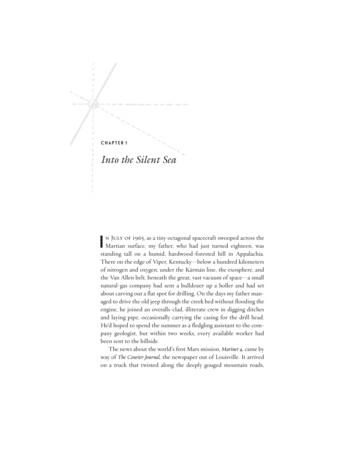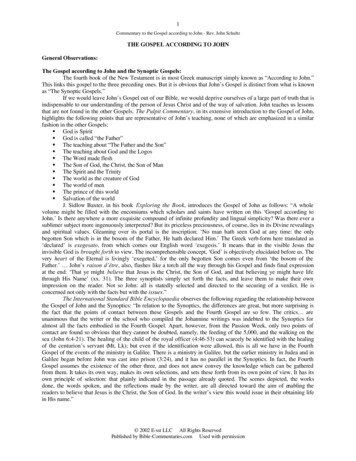
Transcription
CHAPTER 1Into the Silent SeaIn July of 1965, as a tiny octagonal spacecraft swooped across theMartian surface, my father, who had just turned eighteen, wasstanding tall on a humid, hardwood- forested hill in Appalachia.There on the edge of Viper, Kentucky— below a hundred kilometersof nitrogen and oxygen, under the Kármán line, the exosphere, andthe Van Allen belt, beneath the great, vast vacuum of space— a smallnatural- gas company had sent a bulldozer up a holler and had setabout carving out a flat spot for drilling. On the days my father managed to drive the old jeep through the creek bed without flooding theengine, he joined an overalls- clad, illiterate crew in digging ditchesand laying pipe, occasionally carrying the casing for the drill head.He’d hoped to spend the summer as a fledgling assistant to the company geologist, but within two weeks, every available worker hadbeen sent to the hillside.The news about the world’s first Mars mission, Mariner 4, came byway of The Courier- Journal, the newspaper out of Louisville. It arrivedon a truck that twisted along the deeply gouged mountain roads,John 9781101904831 all 2p r1.indd 34/6/21 10:12 AM
4 The Sirens of Marspassed the coal camps, passed Hazard High School, and made its wayinto the small downtown, which was bound like a bobby pin by theNorth Fork of the Kentucky River.That morning, my grandfather had picked up the newspaper fromFouts Drug. He’d tucked it under his arm on his way to work at thehealth department. As a medical technician, he inspected the ColdWar– era bomb shelters that dotted the mountain ridges to makesure the food stocks were safe and drew blood to test for syphilis before young couples got married. He took pride in the fact that everyone in town called him “Doc.” He wasn’t a doctor, but he did givepenicillin shots throughout the hills of eastern Kentucky: down inGilly, up in Typo, in Slemp and Scuddy, in Happy, Yeaddiss, and Busy.When my grandmother wasn’t giving perms, she would help out. Sheliked running the X- ray machine.It was still muggy later that evening as my grandfather meanderedup Broadway— a street that was anything but broad, a single pavedlane that fell steeply into backyards teeming with kudzu. He walkedinto a house that hung like a bat to the side of the ravine, leaving TheCourier- Journal in the attic bedroom, which was spacious now that fourof the six kids had left home. His lanky, wide- eared child, his youngest son, would also leave at the end of the summer, heading two hourswest across the steep forested slopes to attend Berea College. Mygrandfather put the paper on the quilt where my father was sure tofind it, next to his Popular Science magazine, right beneath a poster ofthe pockmarked moon.My father had been spellbound by the idea of the mission, NASA’schance to photograph the planet most similar to Earth. As the mountain town rotated into darkness that Wednesday, my father climbedthe steps, aching and exhausted, and he saw the headline. Above thefold, between a picture of Willie Mays and an article on Vietnam,was what he’d been waiting for: mankind, through mariner,reaching for mars today. He smiled and fell into bed as he read.“Today the fingertip of mankind reaches out 134 million miles toMars, almost touching the only other body in the solar system widelysuspected of harboring life . . .”On the other side of the country, in a canyon north of Pasadena,John 9781101904831 all 2p r1.indd 44/6/21 10:12 AM
Into the Silent Sea 5an eager crowd had gathered on the campus of NASA’s Jet Propulsion Laboratory. Inside JPL’s von Kármán auditorium, intertwinedcables, thick and vaguely subterranean, unfurled from a cluster oftelevision cameras and snaked across the floor to the vans outside.Radio from all over the world was hooked in by relay, and the Britswere poised to broadcast a live television feed, having leased a fulltwo minutes of time from the “Early Bird” satellite. There werethirty- seven phones in varying states of use: thirty- six within thepress bank, and one sitting atop a desk as part of a small fake officewhere the TV broadcasters could be filmed.From floor to ceiling, dominating one side of the great room, wasa full- scale spacecraft, one of the flight- ready spares that had beenused for temperature- control testing. It had the same octagonal magnesium frame as Mariner 4, the same 260 kilograms of hardware andinstrumentation. There were 138,000 parts in all: aluminum tubes,attitude- control jets, pyro end cabling. The solar panels, includingflaps at the end, stretched seven meters. Coated with sapphire glass,glistening in the beams of the television lights, they looked like thewings of a jeweled pterodactyl.Much depended on this craft. In a scene that played out repeatedly over the course of the twentieth century, a Soviet spacecraft wasapproaching Mars at the same time. It had launched from the Baikonur Cosmodrome just two days after Mariner 4. It had reachedMars, but, much to NASA’s delight, it wouldn’t be returning anydata. Halfway there, irregular updates had started coming from itscommunications systems, and then the transmitter died. It was nowno more than “the voiceless ‘Russian spy,’ ” “The ‘Dead’ Soviet Marsmissile.” At long last, the United States had a chance to pull ahead inthe Space Race.There was only one hurdle standing in the way of American triumph: Mariner 4 had to aim and actuate the camera and successfullytransmit its images back to Earth. This was no easy feat. Mars was sofar from the sun that the mission had only 310 watts of usable power,the equivalent of a couple of lightbulbs. The power available to sendthe data stream would be a mere ten watts to start, which would dissipate to a tenth of a billionth of a billionth of a watt by the time itJohn 9781101904831 all 2p r1.indd 54/6/21 10:12 AM
6 The Sirens of Marswas captured in the great dishes of the Deep Space Network, thenewly built antennas on the outskirts of Johannesburg and Canberra,and deep in the Mojave Desert. And even if the data arrived, therewere worries. What if the pictures snapped a bit too early, or a bit toolate? What if the spacecraft inadvertently twisted away from theplanet at just the wrong moment? What if the camera failed to shutoff, recording over the photographs of Mars with pointless photographs of empty space?The Soviets had been trying to reach Mars for five years. In spaceexploration as in all things, they were a formidable adversary. In1960, their first pair of missions had coincided with Premier NikitaKhrushchev’s visit to the United Nations General Assembly in NewYork. He’d commissioned models of the Mars probes and broughtthem along to show the world. Less than two months earlier, his leadrocket engineer had launched into space the first sentient beings thatreturned safely to Earth: two dogs, a gray rabbit, forty mice, two rats,and several flies.But the Soviets were not so lucky this time. As the delegates assembled in New York, the first rocket to Mars failed, climbing just120 kilometers before falling back to Earth and crashing in easternSiberia. Then the second rocket failed: A cryogenic leak had frozenthe kerosene fuel in the engine inlet. Khrushchev had been relying onanother splendid performance from his ambitious young space program and was furious as he paced the halls of the U.N. Before theplenary meeting came to a close, he supposedly went so far as to pulloff his shoe, enraged, and brandish it angrily at another country’s delegate.The Soviets tried again with a trio of missions in 1962. The firstruptured in orbit, fanning out debris that was detected by a U.S. radarinstallation in Alaska. It was nine days into the Cuban Missile Crisis,and the wreckage was momentarily feared by Air Defense Commandto be the start of a Soviet nuclear attack. The third also exploded, themain hull of the booster reentering the atmosphere on ChristmasDay, followed a month later by the payload. The second, however,traveled 100 million kilometers away from Earth and went on tomake the first flyby of Mars— though it was a mute witness to theJohn 9781101904831 all 2p r1.indd 64/6/21 10:12 AM
Into the Silent Sea 7event, as its transmitter failed, the same thing that happened twoyears later.The Soviets kept their defeats to themselves and trumpeted theirsuccesses— which were numerous enough to show that they had a decided lead over the Americans. They had reached practically everymilestone in the Space Race: the first artificial satellite, the first animal in space, the first man, the first woman. They’d intentionallycrashed a spacecraft into the moon and taken the first pictures of itsfar side, and they were now poised to claim the first spacewalk.The United States, by contrast, had successfully completed onlyone planetary mission, Mariner 2 to Venus. Worse, the Venus mission,the “Mission of Seven Miracles,” had barely worked. It was a wonderthat it had managed to collect any data at all, flying by the seat of itspants, “limping on one solar panel and heated to within an inch of itslife.”And getting to Venus was easier than getting to Mars. To reachthe Red Planet, the spacecraft’s systems had to stay alive for an extrahundred days, and the data had to be transmitted twice as far. Transistors were new and bulky, and the microchip had just been invented.The computing power of the whole spacecraft was no better thanthat of a pocket calculator, yet the spacecraft had to rely on a never- before- tested star tracker to point the way. For the first time in history, a NASA probe was drifting into the darkness, traveling awayfrom everything bright in the night— the Earth, the moon, the sun.Just like Coleridge’s ancient mariner, it was poised to be “the firstthat ever burst/Into that silent sea.”Originally, there were to be two Mariner missions to Mars:identical- twin spacecraft, nicknamed the “flying windmills.” Mariners3 and 4 were supposed to zoom by the planet just weeks apart. But theplan went awry when Mariner 3 was lost within minutes of launch.The rocket, an Atlas- Agena, had performed beautifully, but it soonbecame apparent that something was amiss. The data coming backfrom Johannesburg indicated that the spacecraft wasn’t on the expected trajectory. The nose fairing, which was designed to protectMariner 3 from the crushing force of the launch, hadn’t properly detached from the probe. For nine hours, the operations team foughtJohn 9781101904831 all 2p r1.indd 74/6/21 10:12 AM
8 The Sirens of Marsdesperately to find some way to rip it off. They tried everything, including firing the spacecraft’s motor, but the batteries finally gaveway, and Mariner 3 drifted into a derelict orbit around the sun.Mars and Earth align on the same side of the sun only once everytwenty- six months, so the team had just a few weeks to engineer asolution before Mars moved out of range. The material for the nosefairing had been fabricated and tested under the dense atmosphericpressure of Earth, and they realized that its honeycombed fiberglassskin had started to pop like popcorn in the vacuum of space, expanding enough to wedge the nose fairing tight. The engineers workedaround the clock, eventually recognizing that the honeycombed design could be salvaged by poking tiny holes in each cell to equalize thepressure. Just twenty- three days after Mariner 3 had failed, Mariner 4was, improbably enough, ready to launch. It sat on Pad 37 the nightbefore takeoff, shining under the brilliant spotlights. When morningcame, it roared forth, lifting off Cape Kennedy on the wings of anAtlas booster. When the rocket released the spacecraft, the noseshield popped right off, just as it was designed to do.As Mariner 4 left Earth’s shadow, it began to roll through space. Itsfirst task was to locate distant Canopus, the reference star its onboard sensor would use for navigation. The onboard sensor lockedon to Alpha Cephei, far to the north, then moved southward to Regulus, then Zeta Puppis, then an unnamed cluster of three stars. It finally found Canopus, but soon it locked on to a stray light pattern.Then Regulus again. The sensor lost its way no less than forty timesthroughout its long cruise, as small dust particles and flecks of paint,shining fiercely in the sunlight, kept getting dislodged and fallinginto the sensor’s field of view. The spacecraft stumbled the entire wayto Mars, but it survived the 523- million- kilometer journey, circlinghalfway around the sun. NASA was only seven years old, and thisquarter ton of technology was already being heralded as America’sgreatest achievement in space.Inside the JPL Space Flight Operations Facility, among the dark- slacked, short- sleeved men with narrow dark ties clipped to theJohn 9781101904831 all 2p r1.indd 84/6/21 10:12 AM
Into the Silent Sea 9fronts of their shirts, was Bob Leighton, the head of the Mariner 4imaging team. That there was an imaging team at all was itself anunlikely development. The prevailing attitude at the time was thatphotographs were trivial. “Pictures, that’s not science. That’s justpublic information,” recalled a project manager for NASA’s unmanned Ranger missions to the moon.But Leighton had a deep passion for photography. He knew howto render an image, how to bear witness to a pattern of light. Heknew what it meant to really see something. He’d grown up poor inCalifornia— raised by a single mother, who’d made her living as amaid in a Los Angeles hotel. Not long after Leighton graduated, ahigh school photography teacher found him a job at a photographylab for a Hollywood advertising firm. He could very well have endedup a professional photographer, had his penchant for neatness andefficiency not gotten the best of him. In 1939, he threw out what hethought was a stack of scrap paper, only to discover that it was a client’s underexposed blue- light negatives of an elegant steamship sailing under the Golden Gate Bridge. He got his walking papers andreturned to L.A. City College. He transferred into the physics department at Caltech his junior year, then never left, joining the faculty in 1949.Leighton had spent the decade before Mariner 4 working at theMount Wilson Observatory. On just a shoestring budget, he’d builtan image- stabilization device, a “guider,” and taken photos of theplanets. He was supposed to be observing stars and galaxies, chartingredshifts, making fundamental discoveries about astrophysics— notwatching the planets, which were considered too small, cold, andclose to reveal much of anything about the nature of the universe.But he couldn’t resist catching glimpses now and again. When no oneelse was around, mostly on holidays like Thanksgiving and ChristmasEve, he’d sneak peeks through the 1.5- meter telescope.One of Leighton’s students had recently been hired by JPL. Hetold his colleagues about how his former mentor had been able toremove some of the atmospheric turbulence and make movies up atMount Wilson, beautiful movies, for the first time in color, of a rotating Mars. When an amateurish TV experiment was finally sug-John 9781101904831 all 2p r1.indd 94/6/21 10:12 AM
10 The Sirens of Marsgested for the mission, the student pleaded with his old professor:“Bob, as a duty to our community, you’ve got to make a proposal onthe TV experiment to Mars. This other one is terrible.”Leighton acquiesced, and within a matter of months, he designeda gizmo with a slow- scan television camera capable of taking twenty- one photographs of Mars over the course of twenty- five minutes.The hope was to collect images of Elysium, then Trivium Charontis,then sweep across Zephyria and into Mare Cimmerium, catching aglimpse of the desert Electis before petering out to the south of Aonius Sinus. For each image, the camera’s shutter would click open fora fifth of a second. The pictures would be recorded on a ribbon ofmagnetic tape, then radioed back to Earth via Mariner 4’s high- gainantenna. In a sense, it would be the world’s first digital camera.For decades, the best telescopic observations, on the best of days,had only brought Mars a few times closer than the moon appears tothe naked eye. The pictures from Leighton’s system on Mariner 4would be incalculably better, resolving features as small as 3.2 kilometers across. They would give the world a firsthand view of Mars. LikeMartin Luther insisting on a direct relationship with God, the imaging eliminated the need for an interpreter— or “scientific priest,” inthe words of the youngest member of Leighton’s team. The picturescould be spread all over the world for everyone to see, in a languageeveryone could understand.But Leighton knew that photographing Mars was more than justan opportunity to share the mission’s findings directly with the public. It would be the culmination of a long quest to see an entity we’dnever encountered, an entity that had puzzled us for centuries. Whatwas Mars exactly?As inconceivable as it sounds, Mars wasn’t always understood tobe a place. To be sure, the ancients knew there was something intriguing about Mars. The Mesopotamians noticed that it followed astrange loop in the night sky, drifting separately from the “fixed”stars. Everything in the immense night moved together, everythingexcept five little wanderers. Of those, only one appeared as a blazingJohn 9781101904831 all 2p r1.indd 104/6/21 10:12 AM
Into the Silent Sea 11red lamp. It wasn’t only the planet’s distinctive color that made itperplexing but also its motion. Mars drifted eastward, night afternight, in relation to the other stars, but for about ten weeks everycouple of years, it suddenly turned and backpedaled against the zodiac, wandering west for sixty to eighty days before resuming its normal course. In effect, it traced out an elongated loop. Sometimes thesize of the loop was smaller, sometimes larger. From this, Plato concluded that the planets had souls, for what could these retrogradeacts be, he reasoned, if not expressions of free will?It wasn’t until Galileo looked through a spyglass from a columnedterrace in Padua that Mars began its transformation from a glint oflight into a world. Within a short stretch of weeks, it became clear tohim not only where Mars was in relation to other celestial objects butalso what it was. Galileo constructed his perspicillum, or telescope,with his own hands. He mounted it on a stand, and because of its tinyfield of view, he had to be utterly still, barely breathing, hoping thefalling evening temperatures wouldn’t cause the glass to mist over.But through its tiny aperture, he determined Mars to be a sphericalbody illuminated by the sun.As to whether this body was like the Earth, Galileo was not sure.He hedged in a letter he sent in 1612: “If we could believe with anyprobability that there were living beings and vegetables on the moonor any planet, different not only from terrestrial ones but remotefrom our wildest imaginings, I should for my part neither affirm itnor deny it, but should leave the decision to wiser men than I.”The quest to determine the nature of Mars by seeing it betterwould continue for centuries. When Galileo first looked through hisrudimentary telescope, Mars appeared only the size of a poppy seed.But soon concave lenses gave way to convex ones, inverting the image— a minor inconvenience for a much larger field of view. Focallengths began to grow, and new lenses reduced the optical distortionsthat Galileo had tried to mitigate with a cardboard washer. In 1659,the Dutch astronomer Christiaan Huygens stuck a telescope out theattic window of his father’s large house in The Hague and sketchedthe first map of Mars. Within a circle, he drew a v- shaped scribble ofink to denote a dark splotch on the planet’s surface. In the nights toJohn 9781101904831 all 2p r1.indd 114/6/21 10:12 AM
12 The Sirens of Marscome, he watched the shadowy blob disappear and reappear. It lookedvaguely like an hourglass. It would later be called the Hourglass Sea,the first known surface feature on the planet. After mounting a tinymeasuring device to the eyepiece of his rig, he estimated rather accurately that Mars was about 60 percent the size of Earth.Much to Huygens’s surprise, his observations also revealed thatthe length of the Martian day was roughly twenty- four hours, practically the same as Earth’s. These and other similarities between thetwo planets fueled speculation about Mars’s inhabitants. Huygens assumed the presence of intelligent beings, arguing that the planetscould not be viewed as “nothing but vast Deserts, lifeless and inanimate Stocks and Stones,” for doing so would “sink [the planets] belowthe Earth in Beauty and Dignity— a thing that no reason will permit.”He went so far as to speculate about extraplanetary mathematics, envisioning tables of sines and logarithms, since “there’s no reason butthe old one, of our being better than all the World, to hinder themfrom being as happy in their Discoveries, and as ingenious in theirInventions as we ourselves are.”Meanwhile, at Cambridge University, Isaac Newton was developing the basic optics of a new telescope: the reflector. Lenses at thetime could not bring red and blue light to the same focus, resulting ina haze of color surrounding bright objects. So instead of a lens, hedesigned a prototype that collected light by way of a curved metalmirror: six parts copper, two parts tin. It was a tiny instrument, sixteen centimeters long, yielding a magnification of only thirty- fivetimes. Within a century, however, Newton’s design would havesweeping implications, enabling unprecedented enlargements of celestial objects. In 1773, William Herschel, a German- born musicianliving in Bath, England, began experimenting with the constructionof mirrors in his spare time. In collaboration with his brilliantyounger sister, Caroline, who went on to discover scores of cometsand nebulae, he ended up building dozens of reflecting telescopes.From his south- facing garden, he was the first to detect the faint lightof Uranus. He also trained his beautifully handcrafted instrumentsJohn 9781101904831 all 2p r1.indd 124/6/21 10:12 AM
Into the Silent Sea 13on Mars, revealing that the planet had white polar caps, “clouds andvapors floating in the atmosphere,” and seasonal cycles similar tothose of the Earth. In 1784, he gave an address to the Royal Societythat cast Mars as a kind of copy of the Earth, noting that its inhabitants “probably enjoy a situation in many respects similar to our own.”As the observations about the planet continued to roll in, they all fitwith the idea of Mars as another Earth, a planet with its own oceansto sail and lands to walk, a place we could recognize, relate to, andimagine.The idea that Mars was like our planet only drove the quest to seeit better. Newton’s reflector telescope was soon surpassed, as thespeculum metal used for mirrors in large reflecting telescopes wasquick to tarnish, and the polishing process often distorted the curveof the mirror. Instead, refracting telescopes, like Huygens’s, usingtwo lenses instead of two mirrors, came back into vogue in the nineteenth century. These gradually grew and grew, with lenses so largethat gravity began to cause the glass to collapse in on itself. Importantdiscoveries were made, seasonal changes were tracked, moons werediscovered. Telescopes, these magical instruments, transported usand let us see what we had never seen before. For hundreds of years,they were our only way to understand Mars.Not long after I graduated from college, I convinced my fatherto come with me on a trip into thin desert air. He got on an airplanewith me, something he’d only done a few times in his life, and we flewfrom Kentucky to Atlanta and then on to Tucson. We rented a carand drove deep into Arizona’s Old West country, to a hill over a kilometer above the San Pedro River Valley. There was a little hotel,which closed several years ago, at the Vega- Bray Observatory.We checked in, then went to examine the telescopes. There was aforty- six- centimeter reflector beneath a roll- off roof, a couple ofthirty- centimeter Meades, and a half- meter Maksutov- Cassegrain.We zeroed in on a twenty- centimeter Newtonian scope optimizedfor planetary viewing, which we moved to the observing deck justafter dark. There was no tracking system or computer on it, just aJohn 9781101904831 all 2p r1.indd 134/6/21 10:12 AM
14 The Sirens of Marssighting mechanism, which was all we needed. My father knew everything about the night sky.He had spent a good deal of my childhood in the backyard withsky maps from Astronomy magazine tucked beneath his elbow. Asmuch as my father would have loved training for a career in geologyor astronomy, he’d needed a job to make ends meet, and he’d foundone working with the state health department, just like my grandfather had. I’d seen the night sky many times through his oversizedbinoculars, which invariably wobbled in my hands, even though healways tried to hold them steady for me.By this point in my life, I’d been to places like Lick Observatoryand Mount Wilson Observatory. I’d spent my summers interning atNASA, and I’d visited the giant domes. I’d seen the data that state- of- the- art telescopes could collect flickering on computer screens.But there was something different about seeing the sky through amedium- range telescope at Vega- Bray.That night in the desert, I sensed for the first time what Galileoand other early astronomers must have felt, something that’s beenlost in the age of computers. Planetary science used to be an amateurenterprise. Before the dawn of the Space Age, every single practitioner had a direct relationship with the night sky. They were awakewhen others slept, alone with their science and their thoughts, enveloped by the vast physical world. To point the barrel of a telescope ata tiny dot in the sky and then see it as a world, that dot, that very oneright there! Of all the thousand pinpricks of lights, that one is different. That one’s threaded by rings. That one has tiny moons, suspended like marbles. That little alabaster hat is a polar cap. That oneis a world.Standing there in the cold night air with my father, the telescopeat my eye, I felt connected not only to Mars but to Galileo, to Huygens, to Newton, to Herschel. You can’t see something like that andnot yearn to see it better. As I squinted, making adjustment afteradjustment to the dials of the telescope, all I wanted was to fly up toit. Or at least keep the image still. I cursed the atmosphere thatwouldn’t allow it— the same sky that keeps us alive, brings us rains,and softens our shadows. Even the rarefied air of Arizona tremoredJohn 9781101904831 all 2p r1.indd 144/6/21 10:12 AM
Into the Silent Sea 15and swirled and maddeningly made heavens flicker away. Caught inthe grasp of longing and frustration, I could understand why, by thetwentieth century, we had to leave our own planet behind.Two hundred and thirty- one days after Mariner 4 had launched,on the night of July 15, 1965, the tiny levers of the telex machine atJPL began ferociously clicking. Leighton must have felt a surge ofemotion: The Mariner 4 pictures would be the first ever close- up images of anything beyond the moon, as the mission to Venus hadn’ttaken any pictures. Leighton poignantly recognized the differencebetween knowing something about a place and actually seeing it, andso did his imaging team. As Bruce Murray, then only a postdoc, realized, “Looking at a planet for the first time . . . that’s not an experience people are likely to have very often in the history of the humanrace.”The data packets were being flung from Mars to Earth, capturedin the huge bowl of the tracking station at Goldstone Space Communications Complex in the Mojave Desert and transmitted acrossCalifornia via teletype to JPL’s Voyager Telecommunications section.To Leighton, it seemed that the bits of the picture were like pearls,strung kilometers apart on a string from Earth to Mars. The data ratewas only eight and a third bits per second, so it would take eighthours for the first image to be fully transferred. Eight hours of nail- biting, eight hours of pure suspense.The day before, as Mariner 4 was approaching Mars, the operationsteam had decided to relay a command, DC- 25, with an updatedstretch of code to initiate a platform- scanning action, which wouldidentify the planet, followed by a second command, DC- 26, whichwould ensure the camera stopped and didn’t record over the images.The data received before the code was sent suggested that the taperecorder had started and stopped, but there had been some anomalous errors. The tape recorder was also a flight spare, swapped in atthe last minute because of a technical problem with the original. Itwould still be hours, possibly days, before the computers could assemble a real photograph, and now some were second- guessingJohn 9781101904831 all 2p r1.indd 154/6/21 10:12 AM
16 The Sirens of Marswhether the commands should have been sent, whether they mightsomehow confuse the computer.Dick Grumm couldn’t stand the wait. He was in charge of thetape recorder, and he and a few other engineers began brainstormingways they might check the data. It became a contest of sorts, and thewinning idea was to print the single- stream data— groups of digits,indicating the brightness of each pixel— onto a reel of ticker tape. Asthe engineers began snipping the tape into strips and pinning themto the walls, Grumm popped over to a local Pasadena art store insearch of six shades of gray chalk, one for each bit of the six- bit image.He ended up with a pack of Rembrandt pastels. “Chalk” was forschools, not artists, he discovered, and anyway, chalk wasn’t made insix shades of gray.Upon his return, a massive paint- by- numbers artwork had beenassembled and was now ready to be filled in. The Mariner 4 image thatwould eventually be shared with the public was black and white, butDick’s ticker-
one planetary mission, Mariner 2 to Venus. Worse, the Venus mission, the “Mission of Seven Miracles,” had barely worked. It was a wonder that it had managed to collect any data at all, flying by the seat of its pants, “limping on one solar panel and heated to within an inch of its life.” And getting to Venus










